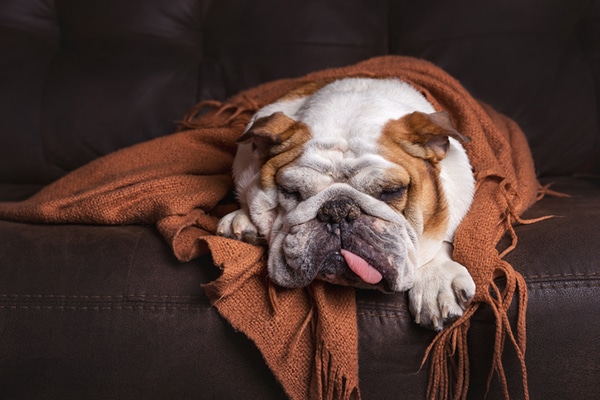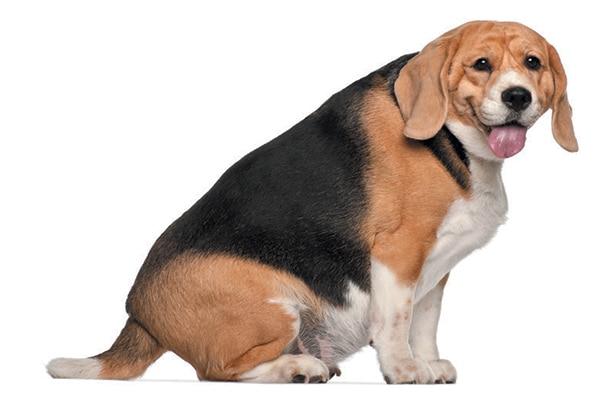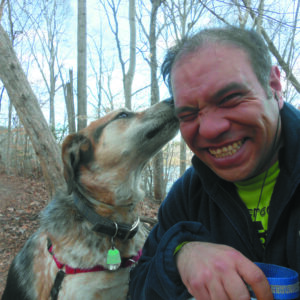When we think of a dog’s metabolism, the immediate association tends to be with words like “slow” or “fast,” and linked with weight gain or loss. Metabolism concerns much more than weight, though; it is fundamentally involved in the operations of every major organ in the body. A small, butterfly-shaped gland located in the neck, called the thyroid, is responsible for governing canine metabolism. Functioning properly, the thyroid secretes hormones directly into the blood that determine how efficiently the dog’s body utilizes available energy.
Thyroid diseases are the most common metabolic issues observed in dogs. Hypothyroidism, or an underactive thyroid, is a medical condition in which a dog’s thyroid is not releasing enough of the hormone thyroxine into the bloodstream. What causes hypothyroidism in dogs? We’re going to take a closer look at low thyroid levels in dogs, and what, if anything, can be done to treat it.
- What causes hypothyroidism in dogs?
- Are there any particular dogs who are at risk for hypothyroidism?
- Low thyroid symptoms in dogs
- Thyroid treatment for dogs
Causes of low thyroid levels in dogs

Hypothyroidism in dogs is a result of too little thyroid hormone reaching the blood. In the vast majority of cases, primary canine hypothyroidism is caused when the thyroid gland itself is damaged and rendered incapable of producing the necessary hormones. This damage can be brought about by inflammation or shrinking, and two diseases are most frequently responsible:
- Lymphocytic thyroiditis: This is an immune system disorder in which the dog’s body registers its own thyroid gland as a threat and begins to attack. As the white blood cells, or lymphocytes, lay siege to the thyroid, it becomes swollen. The larger it gets, the less able the thyroid is to secrete thyroxine into the blood. Aware that it’s not getting enough of the hormone, the thyroid responds by producing more thyroxine. The cycle continues until the thyroid’s ability to create the hormone is exhausted.
- Idiopathic thyroid atrophy: In this scenario, less common than thyroiditis, production of thyroxine declines as the tissue making up the thyroid is replaced by fatty tissue. The thyroid gland shrinks, or atrophies, as a result. The “idiopathic” part refers to the unfortunate fact that the reason for this replacement is unknown.
Though most underactive thyroid problems can be traced to these two disorders, the causes of these disorders themselves are not fully understood.
Are any particular dogs at risk for hypothyroidism?

Any dog can develop low thyroid at any age, but there are certain breeds and age groups that are at higher risk. The breeds most affected tend to be medium or large dogs. A positive diagnosis of hypothyroidism is most frequently made in mature, middle-age to senior dogs, between the ages of 4 and 10 years.
Though the root causes of thyroid inflammation or atrophy are unknown, it is thought that certain breeds are genetically predisposed to develop one or the other. These include:
Neither of the primary forms of hypothyroidism in dogs are acute or sudden, so the condition may be significantly advanced before even the most observant dog owner can discern any obvious symptoms.
Symptoms of hypothyroidism in dogs

While there are at-risk age ranges and breeds, without purposefully tracking thyroid levels, the signs of hypothyroidism in dogs can sneak up on pet owners. Typically energetic and lively dogs of any age and any breed can suffer its ravages, and symptoms can be more difficult to detect in regions that stay warm year round, or among dogs who spend most of their time indoors in climate-controlled homes. Lack of energy can translate to problems maintaining body heat, so be aware of cold sensitivity in a usually hardy dog.
Metabolism, the process of converting food into energy, is centrally important to the way a dog’s body functions. The longer a dog goes with thyroid production below subsistence levels, the more marked the symptoms become. With the general rise in obesity among household pets, coupled with a lack of regular, vigorous exercise, weight gain might be the last sign an owner notices. There are more telling outward physical signs of low thyroid hormone that an owner should be able to discern before they become extreme.
These include hair loss or thinning in spots that are difficult to miss, including the sides of the dog’s body, on the tail, and at the backs of his rear legs. Skin becomes dry and flakes off easily in places such as the armpits, noticeable for dogs who enjoy being scratched there. A darker skin hue might be evident in the affected areas, though the lack of redness or itchiness signals that the condition is not allergy related. Finally, with dogs not known for facial wrinkles or folds, be aware of drooping or saggy skin giving a dog’s “happy” face a sad, drawn appearance.
Diagnosis and treatment of canine hypothyroidism

Low thyroid symptoms are easily mistaken for a range of associated health problems in dogs, so an astute veterinarian has a battery of common tests, including bloodwork for thyroid and cholesterol levels, imaging of the thyroid gland itself, and thyroid hormone supplements to gauge the dog’s reaction. We’ve been looking at primary hypothyroidism; secondary conditions are those like adrenal gland disorders, which can affect thyroid production. Once an accurate, positive diagnosis of hypothyroidism has been obtained, the downside is that there is no cure.
The upside is that the condition is manageable with supplements mixed into a dog’s normal food. The most common synthetic hormone is prescribed under the names Levothyroxine or Soloxine. The appropriate dosage is specific to each dog, which your vet will help determine based on factors such as the dog’s weight. Dogs on the replacement hormone tend to respond well, and although the medication must be taken for the remainder of a dog’s life, monitoring thyroid levels only requires a veterinary visit twice a year.
Read more about dog health issues on Dogster.com:
- Is Your Dog’s Lipstick ‘Stuck’? Could It Be Dog Paraphimosis?
- Bad Dog Breath — 8 Home Remedies
- Home Treatment for a Dog Abscess — If It’s a Visible Skin Abscess
About the author: Melvin Peña trained as a scholar and teacher of 18th-century British literature before turning his research and writing skills to puppies and kittens. He enjoys making art, hiking, and concert-going, as well as dazzling crowds with operatic karaoke performances. He has a two-year-old female Bluetick Coonhound mix named Baby, and his online life is conveniently encapsulated here.
Featured Image Credit: Janie Airey | Thinkstock.






